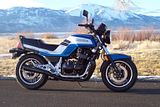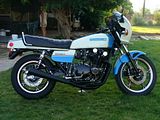1983 GS650L. I have owned it since 1994. I got it after my father died. I put $400 into it back then and was riding it quite a bit. Then for whatever reason it sat for a couple years in the garage.
I dusted it off and with very little work ( I think all I did was put in some new plugs) was riding it again. This was probably around 1999-2000. If I remember correctly, this was when I first had the problem of needing to crank the engine for 20-30 minutes before it would finally turn over. As long as it was warm, or I started it everyday, it seemed to fire OK. But if it sat for 2 days or more I had to do the crank thing to get it started. I was afraid I was going to screw up the starter or some thing.
I quite riding again and bought a house. The bike sat for quite some time (probably about two years or more). About a year to a year-and-a-half ago I said to myself that I need to get this thing running and keep it up as a tribute to my dad. I bought a new battery and put in some new plugs. Changed the oil and gassed it up. It took a lot of cranking but it finally turned over. I was surprised and pleased.
But now my problem persists. Whenever I go to start it, it takes the 20-30 minutes of cranking and it will finally go. I try to start it everyday. Sometimes it will go right away and other times I have to crank. But it will finally start.
Just after it starts, if I give it gas it will die. I have to get it going and let it idle for about 10 minutes before I can twist the throttle without killing it. When I ride, I get hesitation and loss of power after shifting and trying to accelerate.
Someone has suggested cleaning the carbs out but I don't know if that is in my realm of knowledge. Perhaps I underestimate myself. (I probably could do it but I have this habit of being a little shy about new ventures and it seems I remember more than once having a DIY project blow up in my face) Also, right now I'm so broke that if it cost a nickel to get out of jail, I'd be doing life.
Looking forward to hearing opinions and suggestions from any and everyone.
Hopefully... I'LL GET BY WITH A LITTLE HELP FROM MY "NEW" FRIENDS. I'M GONNA TRY WITH A LITTLE HELP FROM MY "NEW" FRIENDS.
Thanks.png)




Comment